
As a student of early modern Ottoman social and economic history, I always feel the shadow of Istanbul in my research. I am not studying the Ottoman capital city or any other urban center per se. The focus of my dissertation project is the countryside, more specifically agrarian social and economic relations.
So, I am constantly thinking about the provinces, not Istanbul. Moreover, as a fellow living in Istanbul for almost nine months now, I also found myself thinking about Istanbul for my blog post, and in a way was conditioned, so to speak, to do so. Of course, this must be the effect of living in Istanbul for a while; Istanbul is one of the overarching themes in most of the ANAMED blog posts. This can also be a good opportunity and exercise for me to think and write about early modern Istanbul. I might even contribute to this collection of posts with my humble “provincial perspective.”
I have been staring at the colored version of Jaspar Isaac’s engraving of Istanbul (dated between 1650 and 1659?) in my room at ANAMED since late September. This engraving has also served me well as a “cool” background for online meetings. Early engravings, maps, and paintings provide us a venue to think about early modern sites, in this case Istanbul and what kind of a city it was. They also reflect the vision and interest of the creators of these representational forms. We must not forget that the city itself is an agent of this image-making process. It gives itself in a specific way to be perceived and related to.
In Jaspar Isaac’s engraving, the city is well surrounded and protected by the walls. Topkapı Palace, Hagia Sophia, The Blue Mosque, Şehzade Mosque, Bayezid II Mosque, Fatih Mosque, Sokollu Mehmet Paşa Mosque, and Süleymaniye Mosque are prominent buildings in the city. It is unlikely that Jaspar Isaac visited Istanbul, but this engraving still reflects a certain image of mid-seventeenth century Istanbul, a city dominated by imperial structures. The Imperial Palace and Mosques are towering over small ordinary houses. The city is well organized and ordered around these imperial establishments. A similar but more colorful sixteenth century Ottoman example is Matrakçı Nasuh’s miniature.
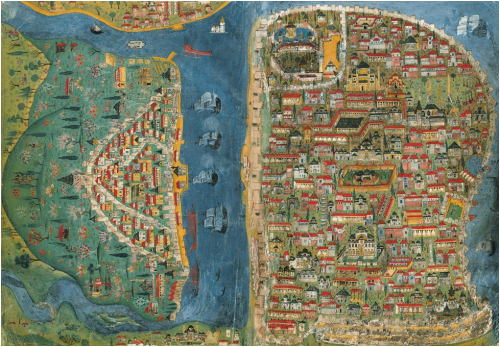
Matrakçı Nasuh, Istanbul.
Source: http://www.ee.bilkent.edu.tr/~history/Ext/matruk.html.
Another seventeenth-century engraving is made by French traveler and draughtsman Guillaume-Joseph Grelot. This more realistic engraving was published in his book, Relation nouvelle d’un voyage de Constantinople, originally in French in 1680 and in English in 1683. In the book, Grelot describes the city with its topography, history, and its prominent buildings and structures. Chapters on Istanbul start with two images of the city from different perspectives. These two images work like windows opening to inner and more specific book sections on the royal palace and chief mosques, especially Hagia Sophia and Süleymaniye Mosques. He also gives his own account of the Greek Church, Greek faith, sacraments, festivals, and religious rituals of the Turks, Muslim ecclesiastical officers, the Ottoman courts of justice, and the civil professions of the Turks. Grelot’s orientalizing tone is prominent throughout the book. At the end, he concludes that these barbarian Turks are the sworn enemies of ingenuity; they are not interested in establishing prosperity in their dominions, and they do not care about the amphitheaters, paintings, sculptures, and other products of noble Arts. In Grelot’s discourse and engravings, the imperial structures have a special place; they overshadow the landscape and the city. Furthermore, the order of imperial establishments is also interesting in the picture. From right to left, they are Sancta Sophia, the Entrance of the Seraglio, the Officers’ Apartments, the Chamber of the Divan (Divan-i Humayun, basically the office of the imperial central government), and the Apartments of the Women of the Grand Seigneur. So, it is not really difficult to see the orientalizing and exoticizing gaze of the author, which takes Istanbul as a city in the middle of the spectacular and glamorous natural scene ruled by barbarous Turks from the Harem.
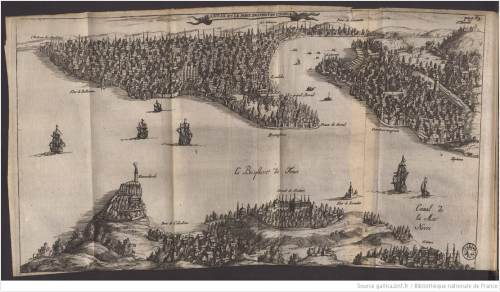
Engraving from Guillaume-Joseph Grelot, Relation nouvelle d’un voyage de Constantinople. Source: https://gallica.bnf.fr/ark:/12148/bpt6k8726892q.
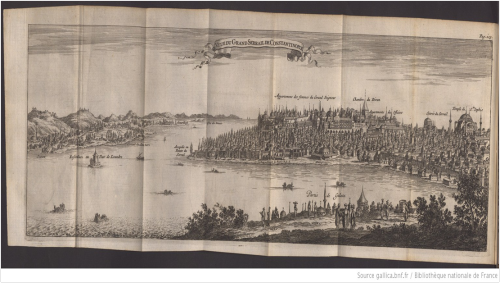
Engraving from Guillaume-Joseph Grelot, Relation nouvelle d’un voyage de Constantinople. Source: https://gallica.bnf.fr/ark:/12148/bpt6k8726892q.
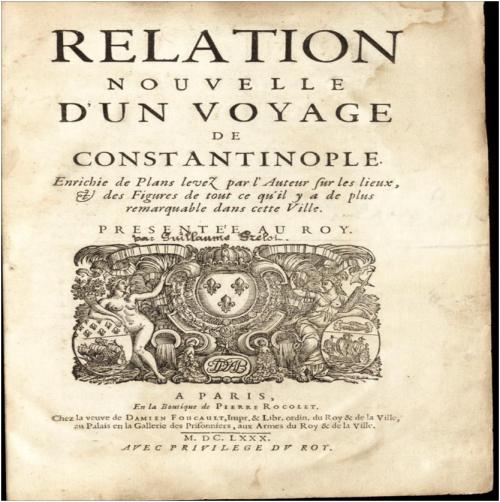
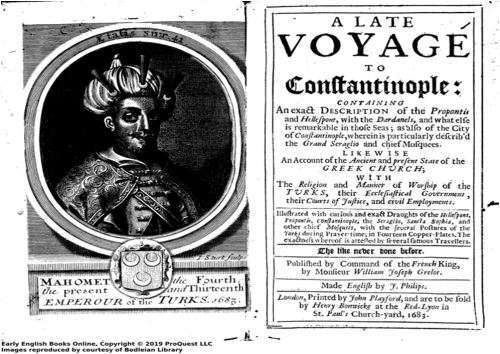
Grelot, Guillaume-Joseph,b.ca.1630. 1683.A Late Voyage to Constantinople. Source: https://www.proquest.com/books/late-voyage-constantinople-containing-exact/docview/2240972919/se-2?accountid=11893.
I do not think that Grelot’s contemporary Evliya Çelebi—an admirer of European engravings and famous Ottoman traveler—would agree with him about the barbarous nature of Turks in Istanbul, especially the Ottoman ruling elite. As a son of a palace goldsmith and a proud Turkish Istanbulite educated in the Ottoman palace, Evliya conceived the city as where civilization prospered, and Islam was an integral part of this urbanite culture. He frequently uses the term Islambol, meaning “full of Islam,” for Istanbul, which was the center of his world. During the course of his travels, many encounters with “rustic peasants and provincial people” give clues about the city and cultural hierarchy between Istanbul and the provinces from an Istanbulite learned gentleman’s perspective. For instance, even if he was proud of his Turkish ancestry, Evliya identifies the spoken language of the Turks in Anatolia as “the language of incapable and unclean Turks (Lisân-ı Etrâk-i nâ-kâbil-i nâ-pâk)” (eds. Dankoff 2005, 32) while also noting that it is his ancestral language. So, something must have happened when his ancestors came to Istanbul.
In addition to this cultural hierarchy, early modern Istanbul’s political and symbolic importance was always emphasized by the ruling elite. Just to give an example, the imperial orders sent to the provinces usually end with the signature be makâm-ı Konstantiniyye el mahmiyye or be makâm-ı Konstantiniyye el mahruse, meaning “from the well protected city of Constantinople” or “written in the Protected city of Constantinople,” and are addressed to “the well-protected domains,” memalik-i mahruse. What I meant by the shadow at the beginning of this post is this political and cultural shadow cast upon the provinces and the city itself by the imperial center and elite. This is also visible in the early modern impressions of the city, a well-ordered and organized city, centered around the imperial sites.
However, this is only one aspect of the city. The same elite perspective can give us other clues about this urban center, as well. In the first decade of the seventeenth century, the unknown janissary author of the code of the corps implies that Istanbul is a place that opens people’s eyes and corrupts them. So, no Christian boy shall be recruited to the corps if they had already visited Istanbul and returned to their provinces (Kafadar 2021, 29–30). Interestingly and ironically, a similar elite vision is reflected in the foundation of a new army called the Nizâm-ı Cedîd (the New Order) in the late eighteenth century. This new army of the new order was an alternative to the janissary corps, representing the old, traditional order, according to the proponents of this project. Recruits for the new army were from Muslim peasants, whose eyes had not been opened by urban life, and hence are uncorrupted by the city (Yaycioglu 2016, 41). Here, both visions suggest that urban life makes people unruly and unsuitable to discipline, in contrast to the docility of the provincial peasants.
Of course, this is the early modern Ottoman elite’s vision, and it does not necessarily reflect the complete social reality. No peasant was docile, and no urbanite was unruly, by their nature. However, it is again not surprising to see such an elite concern about the unruly city and urban crowd with open eyes. After all, Istanbul hosted twelve major revolts between the late sixteenth and the early nineteenth centuries. In that sense, the imperial, orderly shadow cannot really contain the complexity of the social life in the city. The same is true for the provinces.
Looking from the provinces, Istanbul was the seat of power, for sure, and sometimes a place to look for justice. In early modern Ottoman political discourse, the sultanic authority is based upon the just order of the world. Some historians tend to date this understanding back to the ancient Near Eastern state tradition. A tenth-century Islamic schematic formulation reads:
The world is a garden, hedged in by sovereignty
Sovereignty is lordship, preserved by law
Law is administration, governed by the king
The king is a shepherd, supported by the army
The army are soldiers, fed by money
Money is revenue, gathered by the people
The people are servants, subjected by justice
Justice is happiness, the well-being of the world (Darling 2013, 2–3)
A sixteenth-century Ottoman intellectual, Kinalizade, formulates this circular understanding in a more sincere and direct way: no power without troops, no troops without money, no money without prosperity, no prosperity without justice and good administration (Darling 2013, 2–3). The sultan or the state may seem to endow justice to the subjects here. The seat of power also seems like the center of the cosmic order, in this case, Istanbul. A one-dimensional reading of this discourse forgets the starting point of the circle, namely the troops, or, simply, power. In addition, this is just an imperial elite vision and discourse, which corresponds to certain political hierarchies, and it does not reflect the complexity of social and political life. In reality, a provincial demand for justice, either by peasants or other sorts of commoners, is always a calculated and negotiated act involving many parties rather than a one-dimensional patronizing act of the sultan. Furthermore, the imperial seat can also be a seat of injustice and oppression, as it was for the large masses of people with diverse backgrounds, like uprooted peasants or low-ranking military functionaries, in late sixteenth century Anatolia.
Just like all other large early modern cities, Istanbul always needed laborers and food. Apart from Istanbul being the seat of power, looking from the provinces, the city has always been a center of attraction for those looking for livelihood, and it provided many opportunities, thanks to its large urban economy. Migrant workers have always been an important constituent element of the city. Even if the Ottoman authorities tried to prevent migration most of the time due to concerns about the public order, it never stopped. Istanbul was also a giant to be fed. The provision of food was an absolute necessity for the city. Provincial grain was the most essential part of it, and it required a very complex supply and demand chain, involving peasants, workers, big farm-owners, state officers, merchants, all the urbanites, and even rebellious crowds in its absence.
The provincial perspective is not necessarily about the geographical focus of the interpretation. In the case of Istanbul, decentering what early modern Istanbul represented as an imperial capital can be a productive way of reading the question. Neither the city itself nor its relationship with the provinces were perfectly ordered and organized around the imperial establishments of various sorts. The imperial elite visions and political discourses also do not reflect the complete picture of the city and provinces. Evliya Çelebi’s term Islambol might emphasize the abundance of Islam, but the significant Jewish and Christian presence in the city cannot be underestimated; peasants might be quite unruly, though dissent could also be enjoyable for the urbanite.
A short bibliography for the curious readers:
Dankoff, Robert. An Ottoman Mentality: The World of Evliya Çelebi (revised Second Edition). Leiden: Brill, 2006.
Darling, Linda T. A History of Social Justice and Political Power in the Middle East: The Circle of Justice from Mesopotamia to Globalization. London: Routledge, 2013.
Evliya Çelebi. Evliya Çelebi Seyahatnâmesi, 9. Kitap. Edited by R. Dankoff, S. A. Kahraman, and Y. Dağlı. Istanbul: Yapı Kredi Yayınları, 2005.
Grelot, Guillaume-Joseph. A Late Voyage to Constantinople Containing an Exact Description of the Proportis and Hellespont, with the Dardanels, and what Else is Remarkable in those Seas, as also of the City of Constantinople … : Likewise an Account of the Ancient and Present State of the Greek Church, with the Religion and Manner of Worship of the Turks, their Ecclesiastical Government, their Courts of Justice, and Civil Employments : Illustrated … in Fourteen Copper-Plates … / Published by Command of the French King by Monsieur William Joseph Grelot ; made English by J. Philips. London: Printed by John Playford, and are to be sold by Henry Bonwicke, 1683. https://www.proquest.com/books/late-voyage-constantinople-containing-exact/docview/2240972919/se-2?accountid=11893.
Hamadeh, Shirine, and Çiğdem Kafescioğlu , eds. A Companion to Early Modern Istanbul. Leiden: Brill, 2021.
Hamadeh, Shirine. “Invisible City: Istanbul’s Migrants and the Politics of Space.” Eighteenth-Century Studies 50, no. 2 (2017): 173–193.
Kafadar, Cemal. “The City Opens Your Eyes Because It Wants to Be Seen The Conspicuity and Lure of Early Modern Istanbul.” In A Companion to Early Modern Istanbul, edited by Shirine Hamadeh and Çiğdem Kafescioğlu, 25–60. Leiden: Brill, 2021.
Kafadar, Cemal. “Janissaries and Other Riffraff or Ottoman Istanbul: Rebels without a Casue?” In Identity and Identity Formation in the Ottoman World: A Volume of Essays in Honor of Norman Itzkowitz, edited by Baki Tezcan and Karl K. Barbir, 113–134. Madison, WI: Center for Turkish Studies at the University of Wisconsin, 2007.
Sariyannis, Marinos. ”Unseen Rebels: The ‘Mob’ of Istanbul as a Constituent of Ottoman Revolt, Seventeenth to Early Nineteenth Centuries,” Turkish Historical Review 10 (2020): 155–188, doi: https://doi.org/10.1163/18775462-01002009.
Yaycioglu, Ali. Partners of the Empire: The Crisis of the Ottoman Order in the Age of Revolutions. Palo Alto: Stanford University Press, 2016.

